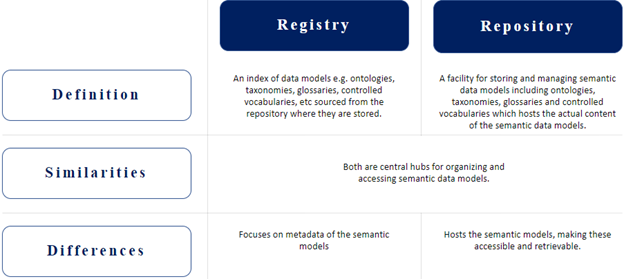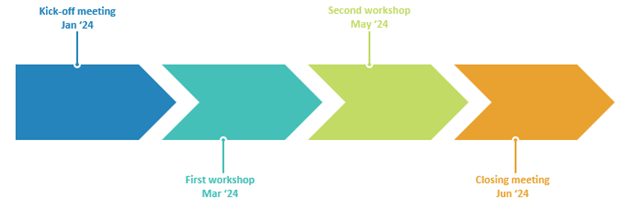As part of SEMIC's ongoing efforts, the development of an EU-wide Registry for semantic models was initiated in October 2023. This blogpost will provide an overview of the ongoing work and its role within SEMIC, highlighting the collaborative approach taken by SEMIC and participating Member States to foster interoperability and collaboration.
What is the Semantic Registry
The Semantic Registry will serve as a platform for Member States to discover and connect with models from other Member States or organisations. It promotes interoperability and collaboration by providing a centralised hub for semantic specifications.
The purpose of the Registry is not to serve as a repository. A repository hosts the specifications and makes them available for download from the repository itself. The Registry on the other hand will host the specifications by providing their metadata. Essentially, the metadata on different semantic specifications from the various national repositories and portals is aggregated in one centralised location without duplicating the models themselves. This makes the models findable with a necessary minimum number of metadata by which the user can refine their search. In the end the user will be redirected to the national repositories and portals, where the specifications themselves can be downloaded. This approach increases discoverability while avoiding duplication.
For the conceptualisation and future piloting of the Semantic Registry, a working group was established early 2024. This working group consists of several members of the SEMIC Team & various Member States. The purpose of the working group was to establish a collaborative environment in which use cases and needed functionalities could be explored. Consequently, adoption and technical requirements originating from the Member States are formed and discussed.
The Registry aims to offer numerous benefits, including improved discoverability, co-designing opportunities, and harmonisation of semantic models. It allows organisations to streamline their workflows and enhance semantic interoperability at the source. However, challenges such as ensuring access to models from other Member States and addressing technical factors must be overcome.

Conceptualisation and requirements of the Semantic Registry
To capture input and requirements from the working group, different meetings and workshops were held. The timeline below outlines the key events and milestones for the Registry, providing a structured approach to its development and implementation.

During the official kick-off meeting in February, the first conceptualisation of the semantic Registry took place. The three focus areas of the initiative were defined:
- Governance to facilitate collaboration and common practices.
- The consumer-oriented user experience of reusers when utilising the Registry.
- The user experience when using the Registry as a publisher.
Additionally, the aim of the Registry working group is to lay foundations for a potential future pilot with several Member States participating which can take place as of Q3 of this year.
The next topic of the agenda were the adoption requirements for the Semantic Registry. To analyse these requirements and facilitate ideation, four roles were defined. Considering the requirements and capabilities needed for the Registry, each role should have access to specific functionalities and features tailored to their respective needs and responsibilities.
- Public administration worker: overseeing and managing policies, services, … for public institutions.
- Model engineer: developing, refining, and managing the semantic models by capturing among others the structure of the data.
- Software developer: designing, developing, and maintaining software applications and systems.
- Casual browser: without any pre-existing knowledge about specific topics, this user can complete a search, analyze the result, make a model selection, follow the link and share the model.
To gather input on which adoption requirements the working group would like to have in the Registry, different use cases were presented. These use cases covered different aspects the Registry would tailor, such as publication, discovery, accessibility, collaboration and integration.
For the last workshop, the technical requirements for the Semantic Registry were presented. Here, the focus was primarily on the metadata and what metadata components the working group would like to see in the Registry. Various repositories were analysed on model reuses and (metadata) file formats. It could be seen that RDF was the to-go-to metadata file format within these repositories.
With the metadata researched, differences in metadata between the national repositories were found. To make a distinction between the different metadata components and the frequency they were found in these repositories, following division was made:
- Common metadata: These are the components found in all repositories, which consist of the Name and Description.
- Less common metadata: These are metadata found in some of the repositories, such as Version_info, URI identifier and Publisher.
- Suggested metadata: Apart from the metadata found, this was a suggestion to add as metadata to the Registry.
To end this workshop, the architectural components were presented and the different ways of accessing the metadata, upstream harvesting and downstream uploading, were explained.
Working Group Outcome
During the workshops, several requirements were captured from the working group to implement in the Registry.
- Requirements captured during workshop 1 include:
- Domain-specific filtering;
- Findability of European Commission models;
- Comparability with previous version(s);
- Availability of model creators’ contact information;
- Ability to decide access rights to models.
- Requirements captured during workshop 2 include:
- Multilingualism and automated translations;
- Importance to have access to individual classes/concepts/properties;
- Ability to connect model specifications to datasets;
- Distinction between access rights and licenses;
- Clarity on which level (national/local/...) a model within a Member State is used/stored;
- Ownership should remain with the respective Member State.
These requirements, captured during the workshops with the Member States, allow the conceptualization of the future pilot to commence smoothly.
Steps towards the future pilot
The kick-off for the creation of a pilot can be initiated as of Q3 2024. The requirements gathered from the working group will be implemented, leveraging from the foundations put in place. This will happen in close collaboration with Member States to ensure that potential improvements can be captured throughout the process.
Four Member States have already given notice to be willing to participate in the pilot project. These Member States are Sweden, Finland, Lithuania and Germany and together will shape the Registry and its functionalities.

